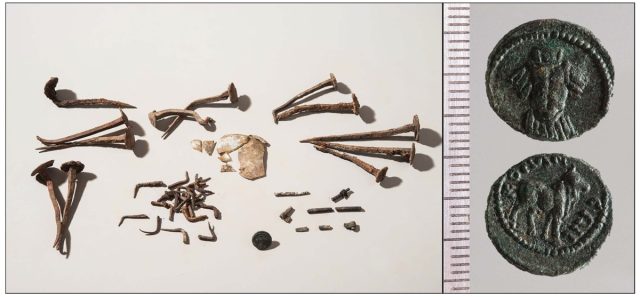
[ad_1]

Sagalassos Archaeological Analysis Challenge
Archaeologists excavating an early Roman imperial tomb in Turkey have uncovered proof of bizarre funerary practices. As an alternative of the standard methodology of being cremated on a funeral pyre and the stays relocated to a remaining resting place, these burnt stays had been left in place and lined in brick tiles and a layer of lime. Lastly, a number of dozen bent and twisted nails, some with the heads pinched off, had been scattered across the burn website. The archaeologists recommend that that is proof of magical pondering, particularly an try to forestall the deceased from rising from the grave to hang-out the dwelling, in accordance with a current paper printed within the journal Antiquity.
Maybe the perfect recognized examples of this sort of superstitious funerary follow are the so-called “vampire” burials that often pop up at archaeological websites all over the world. Within the early Nineteen Nineties, kids enjoying in Connecticut stumbled upon the Nineteenth-century stays of a middle-aged man recognized solely by the initials “JB55,” spelled out in brass tacks on his coffin. His cranium and femurs had been neatly organized within the form of a cranium and crossbones, main archaeologists to conclude that the person had been a suspected “vampire” by his group. They’ve since discovered a probable identification for JB55 and reconstructed what the person might have appeared like.
In 2018, archaeologists found the skeleton of a 10-year-old little one at an historic Roman website in Italy with a rock rigorously positioned in its mouth. This means those that buried the kid—who most likely died of malaria throughout a lethal Fifth-century outbreak—feared it would rise from the useless and unfold the illness to those that survived. Locals are calling it the “Vampire of Lugnano.” And final 12 months, archaeologists uncovered an uncommon instance of individuals utilizing the following pointers in a Seventeenth-century Polish cemetery close to Bydgoszcz: a feminine skeleton buried with a sickle positioned throughout her neck, in addition to a padlock on the large toe of her left foot.
This newest discover is a part of a analysis challenge by KU Leuven in Belgium to excavate a selected space of the Sagalassos website in southwest Turkey. People occupied the area from the late Fifth century BCE via the center of the thirteenth century CE, regardless of important harm from a Seventh-century CE earthquake. The world in query is considerably secluded and set off from the central and residential elements of the town. It consists of a number of contiguous terraces that got here for use for funerary functions. The early Roman imperial tomb was first found in 1990, and archaeologists resumed work on the fast environment in 2012, discovering proof of each burials and cremation spanning some six centuries.

Sagalassos Archaeological Analysis Challenge
The scattered nails had been discovered at a roughly rectangular patch of burnt soil: the stays of a funeral pyre, full with charcoal fragments of pine and scar, in addition to burnt human bones. The burnt bones belonged to a single particular person, most probably a male who died across the age of 18, primarily based on the osteological evaluation. The bone fragments had been nonetheless roughly anatomically organized, with no proof of dealing with them throughout or after the cremation.
Among the charcoal stays seemed to be textiles, suggesting clothes or a shroud. There have been additionally a number of artifacts discovered with the burnt stays: a coin courting from the 2nd century CE, a handful of ceramic vessels from the first century CE, two blown-glass urns, and an merchandise fabricated from labored bone with bronze hinges whose function is unknown. That is proof that the mourners appeared to comply with no less than among the conventional funeral rites.
It is the 41 damaged and bent nails—25 bent at a 90 diploma angle with the heads pinched off, 16 bent and twisted however in any other case complete—recovered from the positioning that set this cremation aside. These weren’t coffin nails, that are often discovered intact, and nails weren’t used within the building of the funeral pyre. So the authors concluded that the damaged nails had been intentionally scattered across the burial website to type a “magical barrier.” There are mentions in a number of historic literary sources of nails getting used to push back illnesses (Livy) or as a safety towards nightmares (Pliny the Elder).
[ad_2]